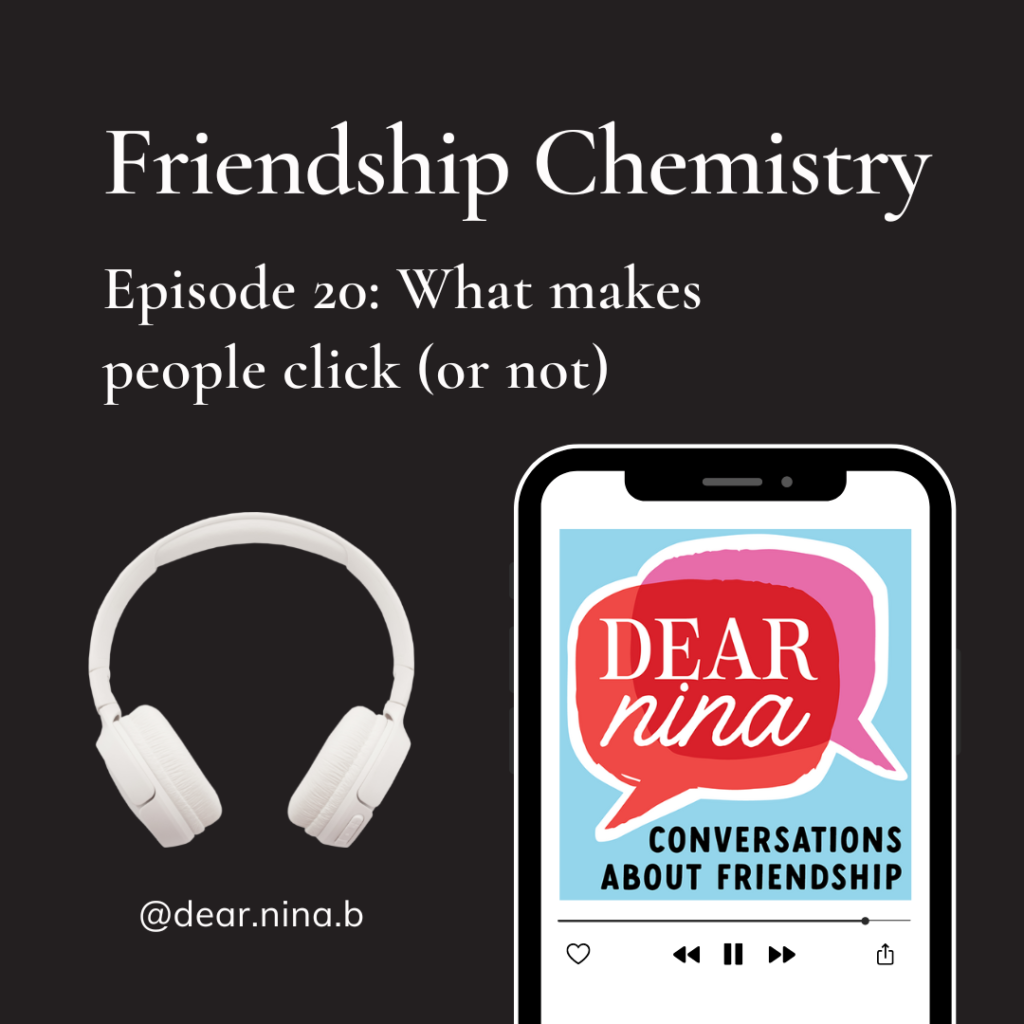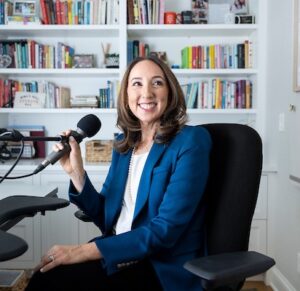Signup for My Substack— Dear Nina: Conversations About Friendship
Let’s talk about friendship chemistry.
Welcome to episode 20 of Dear Nina: Conversations about friendship. There’s someone exciting about a round number isn’t there? Making 19 episodes isn’t that different from making 20, and yet 20 feels extra special.
For this special round-numbered episode, I’m doing a solo one to tackle an issue that comes up in a lot of letters I get. And that is friendship chemistry. Nobody uses those words. What I hear instead are different forms of frustration both friendships not moving faster or getting to the next level. And while I believe the often quoted studies saying it takes 200 hours to make a close friend, what that study doesn’t get at is in an important factor that precedes those 200 hours. And that’s the initial spark of friendship chemistry.
FIND EPISODE #20 ON APPLE PODCASTS, SPOTIFY, OR ANYWHERE YOU LIKE TO LISTEN TO PODCASTS! You can also listen below.
Why Do People Click?
Time and experience together can overcome a so-so initial chemistry, but I want to talk about those magical friendship moments. Those “friendship at first sight” feelings. Have you had them? I’d love to hear about them in the Facebook group if you’re willing to share.
Back to friendship chemistry. I’m fascinated by what makes people click. Within minutes we often know whether we want to pursue a friendship with someone, or not. Is that fair? Maybe not, but it’s reality.
A Relief To Find Reasons For Friendship Chemistry

Nevertheless, I sometimes feel guilty about those snap judgements, but I felt better after reading a book years ago—it was 2011 called Click: The Forces Behind How We Engage with People, Work, and Everything We Do by Ori and Ram Brafman. And it’s CLICK not the clique.
Now, I can’t say I loved the book in a “I can’t put it down” kind of way, but it did help me think about why I might feel friendship chemistry with some people more than others.
The Brafman brothers use research to explain the five “click accelerators” that help foster friendships, business relationships, or any situation where “clicking” with someone is a good thing.
The 5 Click Accelerators are:
1. Similarity:
According to the Brafmans’ research, quantity matters more than quality with this “click accelerator.” You might be disheartened to learn that surface commonalities like having the same name and liking the same band can be enough to create a real connection. As an example, I immediately like anyone named Nina. Doesn’t mean we’ll ultimately be friends, but I do tend to light up when I discover the similarity. Doesn’t mean we’ll ultimately be friends, but I do tend to light up when I discover the similarity. Are we all just total narcissists? Maybe!
2. Vulnerability:
The Brafmans say that by demonstrating your vulnerability over your uber-confidence you invite the other person to display their vulnerability too, which creates trust. Of course this can go too far and have the opposite effect. Ever meet an over-sharer? (Christie Tate and I discussed that aspect of friendships gone wrong in episode four.) I’ve definitely been that over-sharer before, which can create a false sense of closeness if it’s not reciprocal sharing.
3. Proximity:
The authors are not only referring to the same city here. They’re referring to a matter of feet and miles apart—as in dorm rooms, cubicles, neighborhoods and so on. I think this one cannot be overstated. I’m thinking about my own life. Two years ago my husband and I moved about 10 minutes north. Form one suburb of Minneapolis to another. My friends didn’t really change, but I happened to move closer to friends and I definitely see them more and feel even closer. How could I not? We can meet for last minute walks. I’ll sometimes join a friend for 20 minuets of her longer walk if that’s all we have, and it’s no big deal because I’m just walking out my door, catching up for a bit, then heading back home.
4. Resonance:
The authors describe resonance as the ability to stay present in the moment, be in tune with others, demonstrate empathy, elicit empathy from others, and generally be “in the flow.” I think this is a case of you know it when you see it. This is something you can feel immediately and it’s almost hard to give examples. I think it’s the “magic” part people refer to when they’re referring to chemistry.
5. Safe Place:
Think of this as a matter of context. The Brafmans describe the first year of college as a good example. Everyone is in the mindset to make new friends (vulnerability and proximity factor in here too). Another example is connecting during times of “joint adversity,” which could be something intense like surviving an emergency plane landing together, or something infinitely more benign like you and a friend surviving a Zumba class together when you’re not that coordinated. I’d say that people who really stuck with you, even from a distance, during Covid probably feel closer now. Traveling together creates closeness and memories.
Here’s one piece of all this research that’s hard to swallow—sometimes all of those elements are present and we still don’t click with a new potential friend. Even the Brafmans acknowledge that some of this plutonic “love at first sight” chemistry happens with a bit of unexplainable, or at least immeasurable magic. Nevertheless, they claim that if you analyze the times you felt an instant connection, it’s probable that one or more of the five accelerators were at play.
So tell me, do you think it’s possible to KNOW why you click with certain people and not others?
I’d love to hear your thoughts on this and other episodes. You can always find me in the Dear Nina Facebook group!
Affiliate links to Amazon or Bookshop.org could result in a small commission to me.
Let’s connect over all things friendship!
My Substack newsletter about friendship & more
A guide to pitching yourself as a guest
Instagram , TikTok, Twitter, Youtube, Threads
JOIN the Dear Nina Facebook group
Latest posts by Nina Badzin (see all)
- #148 – Tricky Friendship Etiquette for the Modern Age - May 26, 2025
- Dear Nina on NPR - May 24, 2025
- #147 – Share Good News With Your Friends - May 20, 2025
- #146 – Tolerate Uncertainty & Stop the Overthinking Spiral in Your Friendships - May 13, 2025


